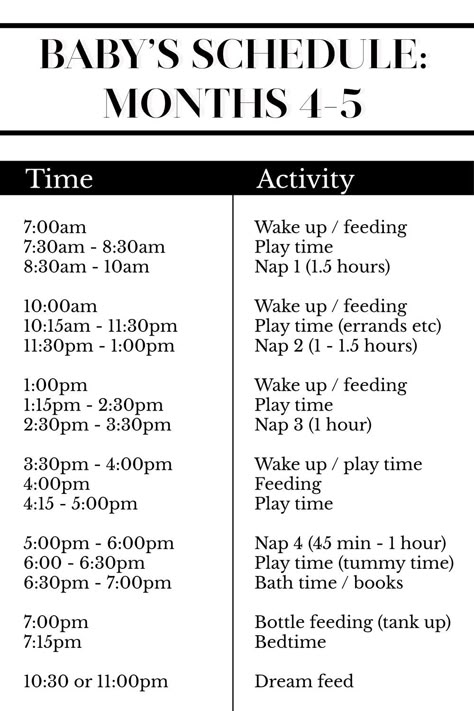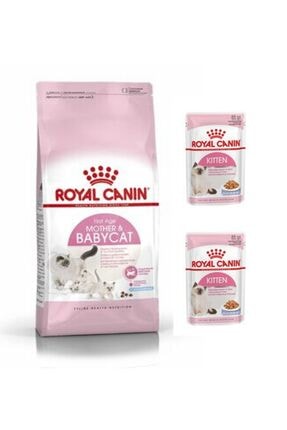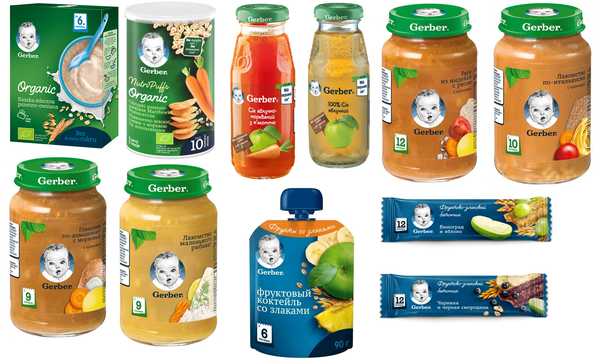Feeding routine for 6 month baby
6-month-old feeding schedule: Timetable
A baby’s 6-month birthday marks an important transition as many infants are ready to start trying solids at this point.
While breast milk or formula should still form the core of a 6-month-old’s diet, some caregivers find that a child’s feeding schedule shifts as they begin eating purees and other solids.
Share on PinterestWhen a baby reaches 6 months of age, purees and other solid foods can usually become part of their diet.Babies typically need to eat every 2–3 hours, five to six times during the day.
It is normal for a baby’s schedule to change from day to day, or for babies to eat different amounts of food each day.
Caregivers can follow a baby’s cues, even if they have established a schedule already. A parent or caregiver does not need to deny food to a baby just because it has already eaten.
Introducing solids
The American Academy of Pediatrics (AAP) advise that parents exclusively breastfeed infants for about 6 months if possible. By the time a baby hits their half birthday, they may be ready to try solids.
A baby may be ready for solids at 6 months if:
- they have good head control
- they can hold their head up for extended periods
- they can sit up with no or very little assistance
- they no longer have the tongue thrust reflect to push food out of the mouth with the tongue
- they show interest at mealtime and lean toward food if a caregiver offers it
At this age, breast milk or formula is still a baby’s most important form of nutrition and solids are an addition.
Not all 6-month-olds are ready for solids. If a baby shows no interest, a caregiver can wait a few weeks and try again.
Giving a baby 1–2 tablespoons of iron fortified cereal or fruit or vegetable purees per feeding can be a good place to start.
Gradually increasing this as the baby’s interest and appetite increase can follow.
To ensure a baby eats sufficient food, the adult can breastfeed or give a bottle before offering solids.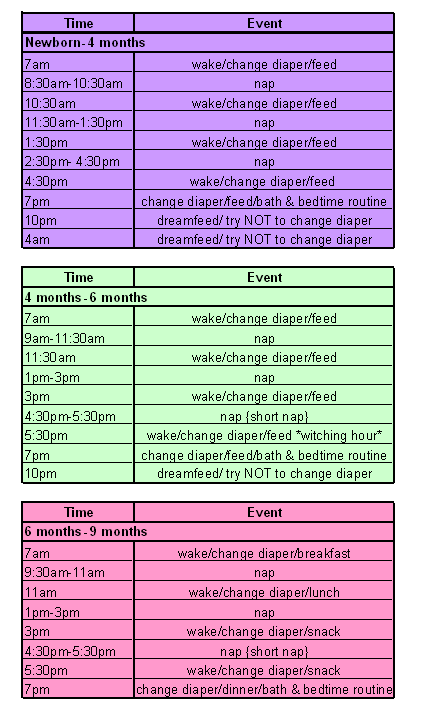
Caregivers can give solid food as a supplement each time they nurse the baby or give a bottle. Or, they can include the baby in family meals by giving solids at mealtime.
At 6 months of age, when an infant may begin to want solids, a caregiver can offer these just once per day.
Choosing a time of day when the caregiver is relaxed and not pressed for time, and the baby is not overly hungry, fussy, or tired often works best.
Once a baby is enjoying their once-a-day solids, the frequency can increase to two and then three times a day.
There is no “right” schedule, but caregivers should plan to increase the number of solids babies get gradually.
At 6 months, the goal is not to introduce new foods and eating habits. Similarly, there is no need to force a baby to eat solids or restrict new food if a baby indicates they want more.
Regardless of their size and eating habits, babies need access to an expanding variety of solid foods.
Most babies will need to try new foods several times before they feel comfortable eating them.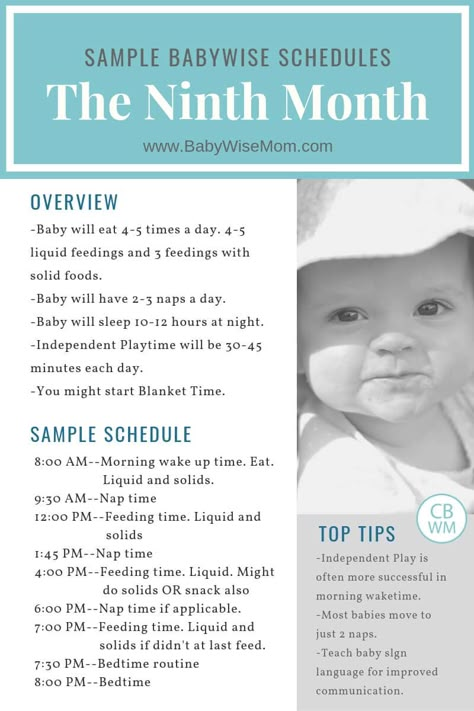 It is fine to let a child eat at their own pace, in the way that feels right to them.
It is fine to let a child eat at their own pace, in the way that feels right to them.
It is acceptable at this age for a baby to play with their food since this is a way of exploring new things.
Breast milk and formula
Breast milk or formula remains the most important food at 6 months of age. The easiest way to ensure a baby eats enough is to nurse or formula feed them on demand when they show signs of hunger.
Research supports the value of feeding on demand.
A longitudinal study of 10,419 children found better academic achievement and a four-point Intelligent Quotient (IQ) advantage at 8 years old among children whose caregivers fed them on demand.
However, the caregivers of these children got less sleep and had lower overall well-being.
These results may point to adults finding a happy medium, such as steadily shaping the baby’s preferred schedule into one that works for them.
In general, caregivers should plan to breastfeed babies 3 to 5 times per day, and sometimes more.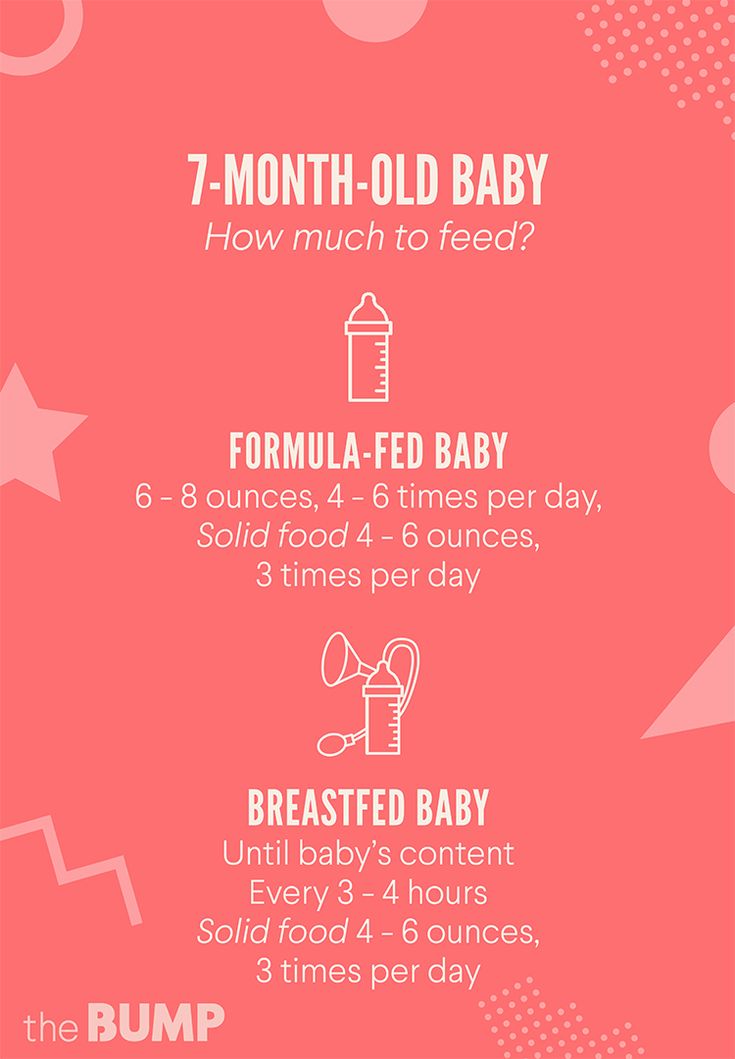 However, babies vary greatly and every 3–4 hours is common, which can amount to up to eight times in 24 hours.
However, babies vary greatly and every 3–4 hours is common, which can amount to up to eight times in 24 hours.
Some babies prefer cluster feedings, during which they nurse several times in a short period. Growing or sick babies may also nurse more frequently.
If a baby has formula, giving 24–32 ounces of iron fortified formula spread over five or six feeds per day is typical. While some babies sleep through the night at 6 months, others will still wake or want to feed.
A nighttime “dream feed” around the time caregivers retire for the evening may help babies sleep longer.
Other liquids
Babies do not need juice at 6 months. The extra calories can decrease a baby’s appetite, and the sugar may damage a child’s developing teeth. Soda and other drinks are not healthful for babies.
Babies can have water beginning at 6 months, or when caregivers introduce solids, whichever is later. Introducing a cup of water along with solid meals may be helpful.
Around 6 months old, some babies begin transitioning from three or four daily naps to two. The baby might take a midmorning nap and a midafternoon nap. At this age, most babies need 12–15 hours of sleep per day, and naps usually last 1–3 hours.
The baby might take a midmorning nap and a midafternoon nap. At this age, most babies need 12–15 hours of sleep per day, and naps usually last 1–3 hours.
Caregivers are best finding a schedule that works for them and the child. Some children are used to falling asleep by nursing or with a bottle. Others happily doze off on their own.
A caregiver can follow the baby’s cues and work to adapt their needs to the family’s schedule slowly.
These feeding tips may help:
- Babies may be hungrier after waking from a long nap. This can be a good time to try solids after offering formula or breast milk to ease their initial hunger.
- There is no evidence that adding cereal to a bottle helps babies sleep longer. Doing so can increase their risk of choking.
- Babies must never have food without close supervision. nor have solids, even very thin purees, in bed.
Deciding what, when, and how to feed a baby can be challenging, especially during the transition to solids. As long as babies get regular breast milk or formula, caregivers do not need to rush the transition to solids or worry that babies are not eating enough.
As long as babies get regular breast milk or formula, caregivers do not need to rush the transition to solids or worry that babies are not eating enough.
Some babies take longer than others to embrace solids, while some will eagerly eat anything. The right schedule is one that works for the baby and family. This schedule may change over time which is also fine.
6 month old feeding schedule
Kim 24 Comments
All activities should be supervised by an adult. As an Amazon Associate, I earn from qualifying purchases. This post may contain affiliate links.
Save
My Favorites
If you’re looking to get your 6 month old on a schedule, today I’m sharing our daily routine with you! If you have a younger baby, be sure to read our 4 month schedule. We gradually went from this schedule to the 6 month schedule so it was an easy transition. You’ll find your baby will give you cues and you’ll know when it’s time to adjust. So now to get to our 6 month old feeding schedule!
So now to get to our 6 month old feeding schedule!
Wake time for us is around 7:30 am so if your baby wakes up earlier or later, just adjust the time slots below.
Wake – 7:30 AM – NURSE/BOTTLE
Breakfast 8:00 AM – Serve Oatmeal or Rice Cereal. I prefer oatmeal and mix it with pumped breastmilk.
Note: I always offer breastmilk or formula first. This is because breastmilk or formula is still the #1 source of nutrition for your baby still and food is still for practice at this age.
9:30 AM – Nap #1 (I do 2 hour wake times at this age)
10:30 AM – NURSE/BOTTLE once up from the nap (naps usually range from 30 mins to 1 hour at this age). This schedule follows the EASY schedule (eat, activity, sleep, you) and is helpful in ensuring your baby doesn’t rely on you to fall asleep by nursing to sleep. If you can, always try to nurse or bottle feed after your baby gets up from their nap. Sometimes this doesn’t work out due to timing, etc but I do my best to try to stick to this. If you are having trouble with your baby sleeping at night read our 5 ways to help your baby sleep through the night.
Sometimes this doesn’t work out due to timing, etc but I do my best to try to stick to this. If you are having trouble with your baby sleeping at night read our 5 ways to help your baby sleep through the night.
12:00 PM – Lunch – offer a veggie/fruit/meat option
12:30 PM – Nap #2
1:30 PM – NURSE/BOTTLE
3:30 PM – Nap #3
4:30 PM – NURSE/BOTTLE
6:00 PM – Dinner – offer a veggie/fruit/meat option
7:30 PM – BED with NURSE/BOTTLE (Start bed time routine between 6:30 – 7PM so baby is asleep by 7:30PM. This gives a 12 hour nighttime)
Note – I have kept my schedule to still offer nursing every 3 hours. As mentioned above, breastmilk or formula at this age should still be your baby’s #1 nutrition source. That’s why I have not extended the time between the sessions. If you find your baby is not accepting the sessions you can cut back and extend the time between sessions. I have noticed my baby is not taking as much during some of the sessions but this is completely normal as he is getting additional calories from his solid feedings.
I have noticed my baby is not taking as much during some of the sessions but this is completely normal as he is getting additional calories from his solid feedings.
That’s our 6 month old feeding schedule at the moment! I hope this schedule will help with your 6 month old. Know that every baby is different. So if you find your baby needs to eat or sleep more or less often just adjust the time in between the schedule. At this age when you slowly introduce solids, you work your way up to 3 meals a day. We did 1 meal to start for a few days, then added lunch then slowly added dinner. This allows time for your baby to adjust.
If you’re getting into solid feeding, one of the best feeding tools we used was a Num Num Dip Spoon. It is great fine motor practice for your baby to learn to use a spoon! Read our review of it here.
We’ve also rounded up the best feeding tools for your baby. You’re going to want to get your hands on some of these innovative feeding products!
Finally, if your baby is still not sleeping through the night – see our 5 tips for getting your baby to sleep through the night.
diet for a 6-month-old baby with breast and artificial feeding, an approximate menu for a week in the table, a diet for a day
Published: 02/10/2021
Reading time: 4 min.
Number of reads: 180626
Author of the article: Ponomareva Yuliya Vladimirovna
Pediatrician, candidate of medical sciences, allergist-immunologist
Changes in a child in the first year of life are very rapid, and each month is not like another. The 6-month milestone is very important, it is largely evaluative and transitional. By this age, most babies have doubled their birth weight, are about 15 cm tall, and some babies have already erupted their teeth. The age of 6 months is also transitional in terms of nutrition. Breast milk or an adapted formula is still the basis of the diet, but with the beginning of the second half of life, all children, without exception, should begin to receive complementary foods. Despite the general graph of growth and weight gain and indicators of psychomotor development, the status and diet of children at 6 months can be very different.
Content: Hide
- The first feeding of 6 months
- The start of complementary foods at 4-5 months
- The second half of the life
- for a week for a child at 6 months
The first feeding of
If the baby is healthy and breastfed, and his mother eats a full and varied diet, exclusive breastfeeding is possible until this age. Cereal complementary foods in this case are preferable to start. This is due to the high energy and nutritional value of cereals, the ability to significantly enrich the baby's diet with a delayed start of the introduction of complementary foods.
However, the rate of expansion of the child's diet in this situation will be accelerated. Before the 8th month of life, it is necessary to introduce all basic food groups into the baby’s menu, since in the second half of the year the need for additional intake of nutrients and micronutrients is very high. Another reason explaining the importance of the rapid introduction of complementary foods is the formation of immunity of the immune cells of the intestine to ordinary food. If a child is introduced to these foods at the age of 4-8 months, the risk of developing food allergies has been proven to be reduced.
If a child is introduced to these foods at the age of 4-8 months, the risk of developing food allergies has been proven to be reduced.
Complementary feeding starts at 4-5 months
In today's life, the nutrition of a nursing mother, unfortunately, is not always complete. Therefore, for most breastfed babies, complementary foods already need to be introduced from 5 months in order to prevent deficient conditions.
If a child is bottle-fed, then by the 4th month of life, the baby will not have enough adapted formula alone, and in this group of children, the timing of the introduction of complementary foods usually shifts a month earlier than in breast-fed babies. Accordingly, by 6 months, children will have vegetable puree and gluten-free porridge (buckwheat, corn and rice) in their diet. In the first half of life, monocomponent meals are used (that is, from one type of grain and vegetables), prepared on the basis of water, breast milk or an adapted mixture.
Fruit puree and juice can be another possible complementary food for children under 6 months of age without allergy symptoms. In a child with a risk of developing or manifesting allergies, the timing of the introduction of fruit complementary foods is shifted to the 8th month.
In a child with a risk of developing or manifesting allergies, the timing of the introduction of fruit complementary foods is shifted to the 8th month.
Second six months of life
Children over 6 months of age can supplement their diet with cereals containing gluten. First of all, these are oatmeal and wheat porridge, and then multi-cereal dishes with the addition of other cereals (millet, barley, rye). If the child does not have any manifestations of allergies, milk porridge can be included in the menu at this age. Bebi Premium industrial baby food products include specially prepared milk that is safe to use in healthy babies in the first year of life.
From the age of 6 months, the baby's diet is expanded with such important products as meat and cottage cheese. These products are a source of high-quality protein, fats, and are also rich in minerals such as iron, calcium, and phosphorus. Pediatricians and nutritionists recommend introducing meat and cottage cheese as part of combined dishes based on a fruit and vegetable and / or grain component in a ratio of 1 (cottage cheese / meat): 4–5 (fruits / vegetables / cereals).
To enrich the diet with polyunsaturated fatty acids in the second half of the year, the menu includes vegetable oil in the amount of 3–5 grams per day, which can be added to the complementary food dish. The volume of each feeding is approximately 150-170 ml, and the child can already stand up to 3.5 hours between meals.
In the table below, we offer a menu of 6 months for a week for a child who started receiving complementary foods at the age of 4-5 months, and by the time the second half of life begins, dairy-free gluten-free cereals, vegetable and fruit purees have already been introduced into his diet.
1st day
| Seeing | 0065 50|||
| Lunch (12.30) | vegetable soup with beef, olive oil | 100/30/3 | compot of drocked 9006, 9006 9 |
| Afternoon snack (16.00) | Plum puree with cottage cheese | 60/40 | |
| Breast milk/formula | 60 062 | ||
| food reception | menu | ml/g | |
| Early morning | breast milk/mixture | 150 | Milki | & Bashas Breakfast (09 cherry Bebi Premium» | 100 |
| 0065 Breast milk/mixture | 150 | ||
| children's soluble cookies "BEBIKI" Classic | |||
| GRUSHERS with rice and Claus | GRUSHIOUS WITH RISE and CRETURE 30 | ||
| Bebi Premium Kids Instant Herbal Tea | 50 | ||
| Bedtime 065 Breast milk/formula | 150 | ||
Rate the article
(Number of votes: 20, average 4. 8)
8)
Share with friends:
Diet for a 4-6 month old baby
Your baby is already 4 months old. He has noticeably grown up, become more active, is interested in objects that fall into his field of vision, carefully examines and reaches for them. The emotional reactions of the child have become much richer: he joyfully smiles at all the people whom he often sees more and more often, makes various sounds.
You are still breastfeeding or have had to switch to formula or formula feeding. The child is actively growing, and only with breast milk or infant formula, he can no longer always get all the necessary nutrients. And that means it's time to think about complementary foods.
The optimal time to start its introduction is between 4 and 6 months, regardless of whether the baby is receiving breast milk or formula. This is the time when children respond best to new foods. Up to 4 months, the child is not yet ready to perceive and digest any other food. And with the late introduction of complementary foods - after 6 months, children already have significant deficiencies of individual nutrients and, first of all, micronutrients (minerals, vitamins, long-chain polyunsaturated fatty acids, etc.). In addition, toddlers at this age often refuse new foods, they have delayed development of chewing skills for thick foods, and inadequate eating habits are formed. It is important to know that, no matter how strange it may seem at first glance, with a delayed appointment of complementary foods, allergic reactions more often occur on them.
And with the late introduction of complementary foods - after 6 months, children already have significant deficiencies of individual nutrients and, first of all, micronutrients (minerals, vitamins, long-chain polyunsaturated fatty acids, etc.). In addition, toddlers at this age often refuse new foods, they have delayed development of chewing skills for thick foods, and inadequate eating habits are formed. It is important to know that, no matter how strange it may seem at first glance, with a delayed appointment of complementary foods, allergic reactions more often occur on them.
When is it advisable to introduce complementary foods as early as 4 months, and when can you wait until 5.5 or even 6 months? To resolve this issue, be sure to consult a pediatrician.
As a rule, at an earlier age (4 - 4.5 months), complementary foods are introduced to children at risk of developing iron deficiency anemia, as well as children with insufficient weight gain and with functional digestive disorders.
The optimal time to start complementary foods for a healthy baby is between 5 and 5.5 months of age.
The World Health Organization recommends that breastfed babies should be introduced to complementary foods from 6 months of age. From the point of view of domestic pediatricians, which is based on extensive practical experience and scientific research, this is possible only in cases where the child was born on time, without malnutrition (since in these cases the mineral reserves are very small), he is healthy, grows well and develops. In addition, the mother should also be healthy, eat well and use either specialized enriched foods for pregnant and lactating women, or vitamin and mineral complexes in courses. Such restrictions are associated with the depletion of iron stores even in a completely healthy child by 5-5.5 months of age and a significant increase in the risk of anemia in the absence of complementary foods rich or fortified with iron. There are other deficits as well.
The first complementary food can be vegetable puree or porridge, fruit puree is better to give the baby later - after tasty sweet fruits, children usually eat vegetable puree and cereals worse, often refuse them altogether.
Where is the best place to start? In cases where the child has a tendency to constipation or he puts on weight too quickly, preference should be given to vegetables. With a high probability of developing anemia, unstable stools and small weight gains - from baby cereals enriched with micronutrients. And if you started introducing complementary foods with cereals, then the second product will be vegetables and vice versa.
If the first complementary food is introduced at 6 months, it must be baby porridge enriched with iron and other minerals and vitamins, the intake of which with breast milk is no longer enough.
Another important complementary food product is mashed meat. It contains iron, which is easily absorbed. And adding meat to vegetables improves the absorption of iron from them.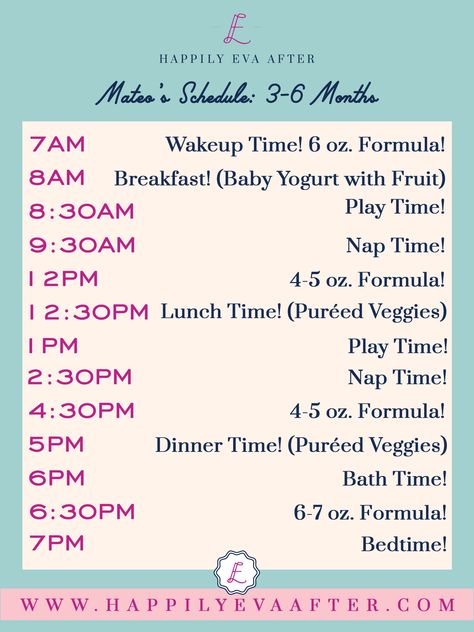 It is advisable to introduce meat puree to a child at the age of 6 months. Only the daily use of children's enriched porridge and meat puree can satisfy the needs of babies in iron, zinc and other micronutrients.
It is advisable to introduce meat puree to a child at the age of 6 months. Only the daily use of children's enriched porridge and meat puree can satisfy the needs of babies in iron, zinc and other micronutrients.
But it is better to introduce juices later, when the child already receives the main complementary foods - vegetables, cereals, meat and fruits. After all, complementary foods are needed so that the baby receives all the substances necessary for growth and development, and there are very few in their juices, including vitamins and minerals.
Juices should not be given between feedings, but after the child has eaten porridge or vegetables with meat puree, as well as for an afternoon snack. The habit of drinking juice between meals leads to frequent snacking in the future, a love of sweets is instilled, children have more tooth decay and an increased risk of obesity.
With the start of the introduction of complementary foods, the child is gradually transferred to a 5-time feeding regimen.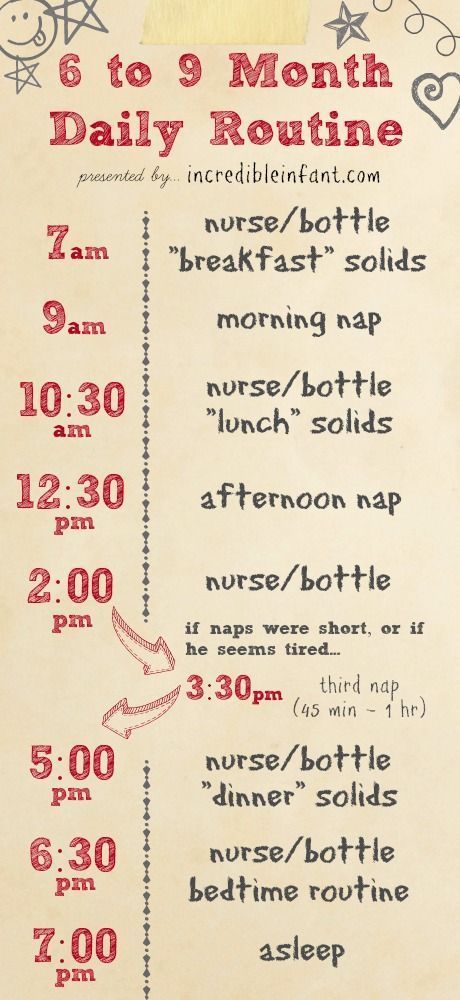
Rules for the introduction of complementary foods:
- preference should be given to baby products of industrial production, they are made from environmentally friendly raw materials, have a guaranteed composition and degree of grinding
- Complementary foods should be offered to the baby by spoon at the start of feeding, before breastfeeding (formula feeding)
- the volume of the product increases gradually, starting with ½ - 1 spoon, and in 7 - 10 days we bring it to the age norm, subsequent products within the same group (cereals from other cereals or new vegetables)
- can be entered faster, in 5 - 7 days
- start introduction with monocomponent products
- it is undesirable to give a new product in the afternoon, it is important to follow how the child reacts to it
- new products are not introduced in the event of acute illnesses, and before and immediately after prophylactic vaccination (should be abstained for several days)
When introducing a new type of complementary food, first try one product, gradually increasing its amount, and then gradually "dilute" this product with a new one. For example, vegetable complementary foods can be started with a teaspoon of zucchini puree. During the week, give the baby only this product, gradually increasing its volume. After a week, add a teaspoon of mashed broccoli or cauliflower to the zucchini puree and continue to increase the total volume every day. Vegetable puree from three types of vegetables will be optimal. The portion should correspond to the age norm. Over time, you can replace the introduced vegetables with others faster.
For example, vegetable complementary foods can be started with a teaspoon of zucchini puree. During the week, give the baby only this product, gradually increasing its volume. After a week, add a teaspoon of mashed broccoli or cauliflower to the zucchini puree and continue to increase the total volume every day. Vegetable puree from three types of vegetables will be optimal. The portion should correspond to the age norm. Over time, you can replace the introduced vegetables with others faster.
After the introduction of one vegetable (bringing its volume to the required amount), you can proceed to the intake of porridge, and diversify the vegetable diet later.
If the child did not like the dish, for example, broccoli, do not give up and continue to offer this vegetable in a small amount - 1-2 spoons daily, you can not even once, but 2-3 times before meals, and after 7 - 10, and sometimes 15 days, the baby will get used to the new taste. This diversifies the diet, will help to form the right taste habits in the baby.
Spoon-feeding should be done with patience and care. Forced feeding is unacceptable!
In the diet of healthy children, porridge is usually introduced after vegetables (with the exception of healthy breastfed children, when complementary foods are introduced from 6 months). It is better to start with dairy-free gluten-free cereals - buckwheat, corn, rice. At the same time, it is important to use porridge for baby food of industrial production, which contains a complex of vitamins and minerals. In addition, it is already ready for use, you just need to dilute it with breast milk or the mixture that the baby receives.
Children suffering from food allergies are introduced complementary foods at 5-5.5 months. The rules for the introduction of products are the same as for healthy children, in all cases it is introduced slowly and begins with hypoallergenic products. Be sure to take into account individual tolerance. The difference is only in the correction of the diet, taking into account the identified allergens.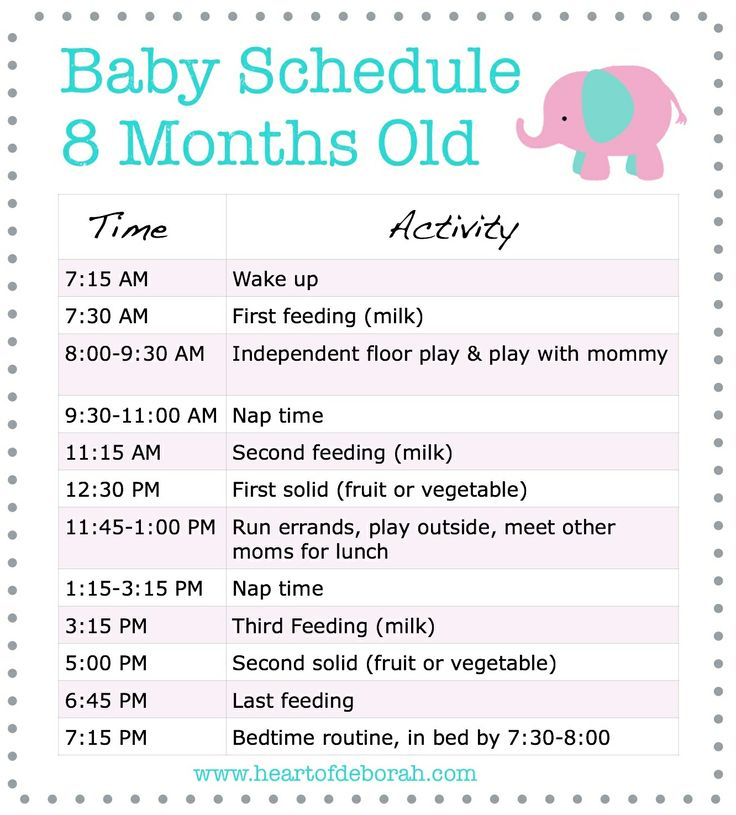 From meat products, preference should first be given to mashed turkey and rabbit.
From meat products, preference should first be given to mashed turkey and rabbit.
Diets for different age periods
Explain how you can make a diet, it is better to use a few examples that will help you navigate in compiling a menu specifically for your child.
From 5 months, the volume of one feeding is on average 200 ml.
Option 1.
If your baby started receiving complementary foods from 4-5 months, then at 6 months his diet should look like this:
| Breast milk or VHI* | 200 ml | |
| II feeding 10 hours | Dairy-free porridge** Supplementation with breast milk or VHI* | 150 g 50 ml |
| III feeding 14 hours | Vegetable puree Meat puree Vegetable oil Supplemental breast milk or VHI* | 150 g 5 - 30 g 1 tsp 30 ml |
| IV feeding 18 hours | Fruit puree Breast milk or VHI* | 60 g 140 ml |
| V feeding 22 hours | Breast milk or VHI* | 200 ml |
* - infant formula
** - diluted with breast milk or VHI
Option 2.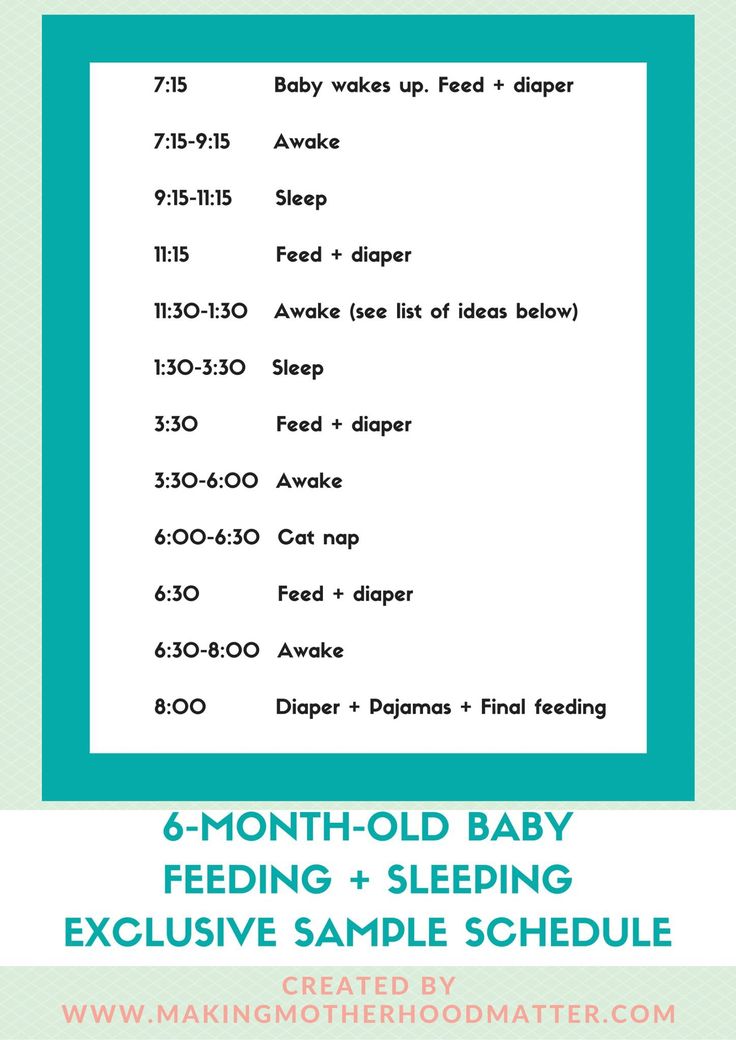
* - infant formula Option 3. : ** - diluted with breast milk Up to 7 months, increase the volume of porridge and vegetable puree to 150 g and introduce fruit puree. I feeding
6 hours Breast milk or VHI* 200 ml II feeding
10 hours Dairy-free porridge**
Fruit puree 150 g
20 g III feeding
14 hours Vegetable puree
Meat puree Vegetable oil
Fruit juice 150 g
5 - 30 g
1 tsp
60 ml IV feeding
18 hours Fruit puree
Breast milk or VHI* 40 g
140 ml V feeding
22 hours Breast milk or VHI* 200 ml
** - diluted with breast milk or VHI 
I feeding
6 hours Breast milk II feeding
10 hours Dairy-free porridge**
Breast milk supplement 100 g III feeding
14 hours Vegetable puree
Meat puree Vegetable oil
Breast milk supplement 100 g
5 - 30 g
1 tsp IV feeding
18 hours Breast milk V feeding
22 hours Breast milk 